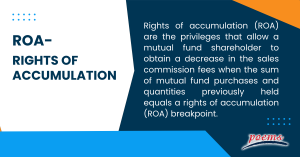Rights of accumulation (ROA)
Table of Contents
Rights of accumulation
Rights of accumulation (ROA) are the privileges that allow a mutual fund shareholder to obtain a decrease in the sales commission fees when the sum of mutual fund purchases and quantities previously held equals a rights of accumulation (ROA) breakpoint.
The rights of accumulation encourage the investor to make numerous investments in the mutual fund. And instead of spreading his funds among several mutual funds, the investor is enticed by the breakpoints method to continue with a single mutual fund.
Here we provide a detailed overview of everything an investor should know about rights of accumulation.
What are the rights of accumulation?
With the use of a right of accumulation (ROA), investors can gather their assets and those of certain connected entities, such as their spouses and children, to reach the investment thresholds where breakpoint discounts are accessible.
Mutual fund shareholders have the right to accumulate their holdings over time. This means they can add to their position in the fund by reinvesting their dividends and capital gains. This allows them to compound their returns and grow their investment over the long term.
Mutual fund shareholders also have the right to withdraw their money from the fund at any time. However, they may be subject to fees or taxes if they do so.

Importance of rights of accumulation
Rights of accumulation have a major importance for mutual fund shareholders.
- They allow shareholders to reinvest their dividends and capital gains into new shares of the fund without paying taxes on those gains. This can help shareholders to compound their returns and build their wealth over time.
- Additionally, reinvesting dividends and capital gains can help offset any losses the fund may experience.
- And finally, it gives shareholders the ability to dollar-cost-average their investment, which can help to reduce risk.
What is the purpose of rights of accumulation?
The purpose of rights of accumulation to mutual fund shareholders is twofold. First, it allows shareholders to increase their investment in the fund without incurring additional transaction costs. Second, it will enable shareholders to build a more significant position in the fund over time, leading to greater returns.
The concept of rights of accumulation is quite effective because it encourages investors to continue investing in the stock markets since the savings from profits that pass each breakpoint keep them inspired to invest continually for a more extended period.
The prospectus for every mutual fund will describe their specific technique for determining the rights of accumulating breakpoints. Based on the breakpoints and waivers granted at each one, the information assists the investors in deciding whether to participate in the fund for a longer or shorter period.
How are rights of accumulation calculated?
The rights of accumulation to mutual fund shareholders are calculated based on the total number of shares the shareholder owns in the fund. The more shares a shareholder owns, the more rights of accumulation they have. These rights allow shareholders to accumulate more fund shares over time, leading to greater profits.
Example of rights of accumulation
Mutual fund shareholders have the right to accumulate their shares over time. This means that they can reinvest their dividends and capital gains into the fund, which can help increase their overall investment. This can be a valuable strategy for long-term investors looking to build their portfolios over time.
Let’s look at an example:
An investor wishes to buy $5,000 worth of Fund XYZ Class A shares with an intermediate front-end sales fee of 5.00%. The $5,000 investment is in addition to the investor’s existing $55,000 investment in Class A shares of the fund. The rights of accumulation breakpoint schedule for Fund XYZ is the same as what FINRA has laid down.
The investor now has a $60,000 accumulation, with the last investment of $5,000. So, their extra purchase of $5,000 qualifies for a lower front-end sales charge of 3.75%.
Frequently Asked Questions
No, rights of accumulation do not typically apply to C shares. This is because C shares are generally geared towards long-term investment, and as such, investors are not looking to accumulate large quantities of them. Instead, they are happy to hold on to their C shares for the duration of their investment.
Accumulation planning is a financial strategy involving setting aside money regularly to achieve a specific financial goal. The money accumulated can be used for various purposes, such as investing, retirement, or purchasing a home. To make the most of this financial strategy, it is important to have a clear goal in mind and be disciplined in setting aside money regularly.
There are a few key rights that come with accumulation breakpoints in finance. First and foremost, investors can receive a higher rate of return on their investment. Additionally, they are also able to take advantage of lower taxes and fees. And finally, investors are also able to take advantage of compounding interest. All these factors together can make a big difference in the overall return on investment.
Rights of accumulation refer to the rights of an individual to accumulate wealth or income over time. And on the other hand, a letter of intent is a document expressing an individual’s intention to do something.
The primary key differences between rights of accumulation and letters of intent are that rights of accumulation are typically associated with financial matters, while letters of intent are not. And secondly, rights of accumulation are generally permanent, while letters of intent are not.
The breakpoint is the price over which an investor is qualified to get a decrease in the sales fee when purchasing shares in a large mutual fund. The idea of breakpoints allures investors with extra discounts on their investments.
The rights of accumulation breakpoint encourage more significant further mutual fund investments. Investors often want to invest their resources in profitable ventures repeatedly. These breakpoints encourage investors to constantly buy mutual funds in a single large payment or over time.
Related Terms
- Mark-to-market
- Federal Open Market Committee
- FIRE
- Applicable federal rate
- Assets under management
- Automated teller machine
- Central limit theorem
- Balanced scorecard
- Analysis of variance
- Annual percentage rate
- Double Taxation Agreement
- Floating Rate Notes
- Average True Range (ATR)
- Constant maturity treasury
- Employee stock option
- Mark-to-market
- Federal Open Market Committee
- FIRE
- Applicable federal rate
- Assets under management
- Automated teller machine
- Central limit theorem
- Balanced scorecard
- Analysis of variance
- Annual percentage rate
- Double Taxation Agreement
- Floating Rate Notes
- Average True Range (ATR)
- Constant maturity treasury
- Employee stock option
- Hysteresis
- RevPAR
- REITS
- General and administrative expenses
- OPEX
- ARPU
- WACC
- DCF
- NPL
- Capital expenditure (Capex)
- Balance of trade (BOT)
- Retail price index (RPI)
- Unit investment trust (UIT)
- SPAC
- GAAP
- GDPR
- GATT
- Irrevocable Trust
- Line of credit
- Coefficient of Variation (CV)
- Creative Destruction (CD)
- Letter of credits (LC)
- Statement of additional information
- Year to date
- Certificate of deposit
- Price-to-earnings (P/E) ratio
- Individual retirement account (IRA)
- Quantitative easing
- Yield to maturity
- Letter of Intent
- Return on Invested Capital (ROIC)
- Return on Equity (ROE)
- Return on Assets (ROA)
Most Popular Terms
Other Terms
- Physical ETF
- Initial Public Offering
- Buyback
- Secondary Sharing
- Bookrunner
- Notional amount
- Negative convexity
- Jumbo pools
- Inverse floater
- Forward Swap
- Underwriting risk
- Reinvestment risk
- Final Maturity Date
- Payment Date
- Secondary Market
- Margin Requirement
- Pledged Asset
- Yield Pickup
- Subordinated Debt
- Trailing Stops
- Treasury Stock Method
- Stochastic Oscillator
- Bullet Bonds
- Basket Trade
- Contrarian Strategy
- Exchange Control
- Notional Value
- Relevant Cost
- Dow Theory
- Speculation
- Stub
- Trading Volume
- Going Long
- Pink sheet stocks
- Rand cost averaging
- Sustainable investment
- Stop-limit sell order
- Economic Bubble
- Ask Price
- Constant prepayment rate
- Covenants
- Stock symbol
- Companion tranche
- Synthetic replication
- Bourse
- Beneficiary
- Witching Hour
- Widow and Orphan stock
- Public Float
- Closing Price
Know More about
Tools/Educational Resources
Markets Offered by POEMS
Read the Latest Market Journal

Back in Business: The Return of IPOs & Top Traded Counters in March 2024
Start trading on POEMS! Open a free account here! At a glance: Major indices continue...

Weekly Updates 15/4/24 – 19/4/24
This weekly update is designed to help you stay informed and relate economic and company...

From $50 to $100: Unveiling the Impact of Inflation
In recent years, inflation has become a hot topic, evoking strong emotions as the cost...

Japan’s Economic Resurgence: Unveiling the Tailwinds Behind Nikkei 225’s Record Leap
Source: eSignal, Intercontinental Exchange, Inc. In the heart of Japan’s economic landscape, the Nikkei 225...

Weekly Updates 8/4/24 – 12/4/24
This weekly update is designed to help you stay informed and relate economic and...

What Makes Forex Trading Attractive?
In a world where the click of a button can send goods across oceans and...

Weekly Updates 1/4/24 – 5/4/24
This weekly update is designed to help you stay informed and relate economic and company...

How to soar higher with Positive Carry!
As US Fed interest rates are predicted to rise 6 times this year, it’s best...












